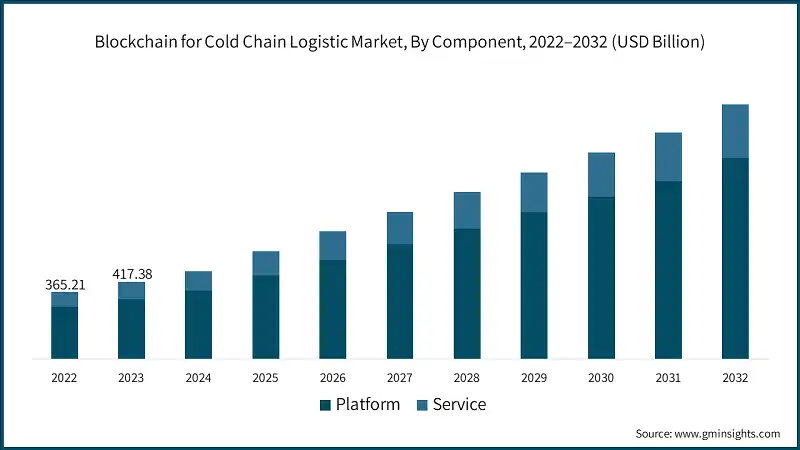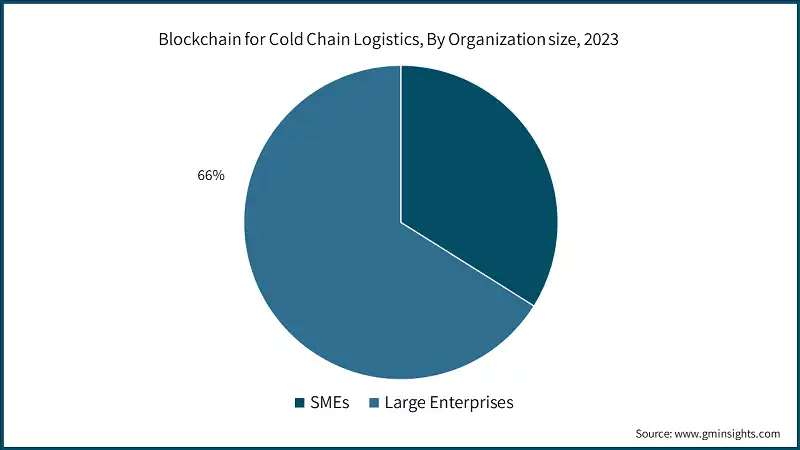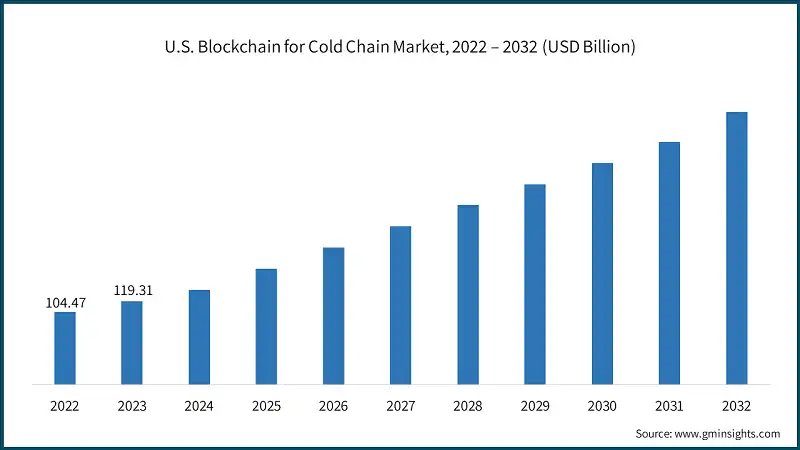News
Blockchain for Cold Chain Logistics Market Size, 2024-2032 Report

Blockchain for Cold Chain Logistics Market Size
Blockchain for Cold Chain Logistics Market size was valued at USD 417.38 billion in 2023 and is anticipated to register a CAGR of over 14.1% between 2024 and 2032. The increasing demand for real-time data analysis is a critical driver in the growth of the market. Blockchain in logistics has been continuously focusing on eliminating paperwork & enabling better traceability. Industry players are focusing on the potential of blockchain technology to enhance transparency and to reduce costs in cold chain logistics.
In November 2022, Microsoft Corp. announced the Microsoft Supply Chain Platform, which helps organizations maximize their supply chain data estate investment. Microsoft brought AI, collaboration, low-code, security, and SaaS applications in a composable platform which had resulted in development in the field of blockchain for cold chain logistic market.
Usage of blockchain technology has improved supply chain transparency and monitor provenance, this leads to gathering data about how goods are manufactured, how they are handled, where they come from such information is stored in blockchain system. This indicates stable, easily accessible & shareable data, which promotes logistic key players to trace and track the goods. Companies can use this information to grant proof of authenticity for products in healthcare and pharmaceutical shipments.
| 2023 |
| USD 417.38 Billion |
| 2024 – 2032 |
| 14.1% |
| USD 1.35 Trillion |
| 2021 – 2023 |
| 270 |
| 369 |
| Component, deployment, organization size, application, end-use industry, & region |
|
|
For instance, in June 2024 Overhaul, a global pioneer in proactive supply chain risk management and intelligence, unveiled its groundbreaking Cold Chain Quality Solution. This advanced software leverages blockchain technology to deliver unparalleled risk and quality management for time and temperature-sensitive cargo in the pharmaceutical, healthcare, and high-value food and beverage sectors.
The adoption of blockchain technology in cold chain logistics requires substantial financial investment. This includes costs related to the development, integration, and maintenance of blockchain systems, as well as training personnel to effectively use the technology. Small and medium-sized enterprises (SMEs) may find it particularly challenging to allocate the necessary funds, potentially limiting the widespread adoption of blockchain solutions within the industry. Additionally, the return on investment (ROI) may not be immediately apparent, making it difficult for companies to justify the initial expenditure.
Blockchain for Cold Chain Logistics Market Trends
Hybrid blockchain has emerged as a pivotal trend in the blockchain for cold chain logistics industry, it combines into two interfaces, private blockchain with independent ledgers and a public blockchain designed to ease data verification. It employs private blockchain functionality to ensure that the data remains secure in its original form. Transparency characteristics in hybrid blockchain has proved to perform uncommonly as compared to public & private blockchain system. It provides high-speed operations and is simpler to manage.
By using hybrid blockchain technology, companies can enhance their cold chain logistics operations, real-time tracing & monitoring capabilities enable proactive management of inventory, reducing the risk of loss and progressing overall efficiency. It complements Internet of Things (IoT) devices and Artificial Intelligence (AI) algorithms used in cold chain logistics. This addition allows for predictive analytics and proactive maintenance to guarantee optimal conditions for machinery and equipment’s. For instance, in November 2022, Maersk and IBM partnered to implement blockchain to enhance transparency and efficiency in tracking goods such as pharmaceuticals, food items & oters across their supply chains.
The rising demand for traceability and regulatory compliance in the food and pharmaceutical industries is a significant driver of blockchain for cold chain logistics market growth. Blockchain technology provides an immutable record of each transaction and movement in the supply chain, enabling companies to demonstrate compliance with safety regulations and quality standards. This transparency is critical for preventing foodborne illnesses and ensuring the safety of pharmaceutical products.
For example, in April 2024, Ripple and HashKey DX have partnered to introduce XRP Ledger (XRPL)-powered enterprise solutions in Japan, aiming to transform supply chain finance and offer cutting-edge solutions to institutional investors. This strategic collaboration leverages HashKey DX’s successful blockchain-powered supply chain finance solutions, which have been widely adopted in mainland China, and will now be introduced to the Japanese market.
Blockchain for Cold Chain Logistics Market Analysis

Based on components, the market is segmented into platform and service. The platform segment accounted for the largest market share with over 77% share in 2023.
- These components facilitate transparency, security, and regulatory compliance throughout the supply chain. Blockchain platforms in cold chain logistics are growing due to enhanced traceability, compliance automation, and security. They integrate IoT for real-time monitoring, ensure regulatory adherence, and streamline supply chain operations. Platforms incorporate compliance features that adhere to international regulations and industry standards governing cold chain logistics. This capability ensures adherence to food safety guidelines, quality control measures, and sustainability initiatives, thereby mitigating risks and ensuring operational efficiency.

Based on organization size, the blockchain for cold chain logistics market is divided into SMEs, and large enterprises. SMEs are the fastest growing segment, with a CAGR of over 15% during the forecasted period.
- Small and Medium Enterprises (SMEs) are the fastest-growing segment in the market due to several reasons. Blockchain technology offers SMEs affordable and scalable solutions for improving transparency and traceability in their supply chains. This helps them to work in the boundary of regulations and meet consumer demand for product integrity and safety.
- Blockchain reduces operational costs by eliminating intermediaries and automating documentation processes, which is particularly beneficial for resource-constrained SMEs. SMEs can leverage its capabilities to improve their efficiency, to build trust with partners and customers, and to gain a competitive edge. SMEs are increasingly adopting blockchain to drive innovation and growth in the cold chain logistics sector.

North America blockchain for cold chain logistics market held the largest share of over 33% in 2023. North America region aids from an advanced IT infrastructure, a strong base of technology companies, and widespread adoption of blockchain technology in cold chain logistics. North America will maintain the dominant position in upcoming years in this market, highlights continued investment in innovative blockchain technologies, stringent regulatory standards, and high demand for perishable goods in the region. Blockchain for cold chain logistics evolved with trends such as startups and established companies are focusing on investing heavily in blockchain solutions.
In United States, industries like pharmaceuticals and perishable goods are adapting blockchain to guarantee the integrity of temperature-sensitive products. Regulatory bodies such as the FDA support these initiatives. Collaborations between industry leaders and technology providers foster the development of robust blockchain platforms. This positive approach hardens the US as a prime candidate in blockchain adoption for cold chain logistics.
In China, blockchain technology has gained significant traction within the cold chain logistics due to heavy regulations in logistics regulations and the imperative for transparency throughout the supply chain. Ongoing challenges with food safety incidents, prompting regulatory bodies and industry players to focus on the safety of goods in supply chain. The country is heavily investing in blockchain technologies to enhance supply chain efficiency and ensure food safety. Government initiatives promoting digital transformation and support for local tech companies have accelerated the adoption of blockchain solutions.
In Germany, blockchain has evolved in cold chain logistics to maintain the integrity of pharmaceuticals and other goods. The technology provides immutable records of temperature data, working in control with the regulatory standards and gaining trust among the consumers and stakeholders. Companies are investing in blockchain solutions to optimize smooth flow of supply chain processes and minimize environmental impact.
Japan’s commitment to technological advancement positions it as a key player in the blockchain for cold chain logistics market. Japanese firms are at the forefront of adopting blockchain to improve supply chain transparency and traceability, particularly in the food and pharmaceutical sectors. The collaboration between traditional industries and technology companies fosters innovation, with many firms investing in pilot projects and scalable solutions to enhance operational efficiency and ensure compliance with stringent regulations.
South Korea is rapidly emerging as a leader in the blockchain for cold chain logistics, fueled by its advanced technological landscape and strong consumer electronics industry. South Korean companies are increasingly adopting blockchain solutions to improve supply chain visibility and reduce waste in food distribution. The government’s proactive stance on supporting blockchain initiatives and fostering partnerships between industry and academia further accelerates the implementation of innovative logistics solutions in the cold chain sector.
Blockchain for Cold Chain Logistics Market Share
Amazon Web Services, Inc. & International Business Machines Corporation (IBM) hold a significant share of over 15% in the market. The blockchain for cold chain logistics industry is dominated by companies including AWS, Microsoft corporation, and IBM, who offer real-time data processing, analytics, and AI integration. Their competitive companies in the industry of market lies in integrating advanced analytics capabilities such as machine learning and predictive analytics into streaming data pipelines. This integration facilitates real-time monitoring of temperature-sensitive goods throughout the supply chain, focusing on finest conditions and compliance with regulatory standards.
Microsoft focuses on integrating blockchain technology into their Azure cloud platform to improve cold chain logistics. Their strategy involves presenting assured data management solutions that influence blockchain’s immutability for tracking and verifying product conditions. SAP SE provides blockchain solutions that integrate with their ERP systems to optimize cold chain logistics. Their strategy highlights real-time data processing and analytics to improve transparency and streamline supply chain operations in logistics.
Blockchain for Cold Chain Logistics Market Companies
Major players operating in the blockchain for cold chain logistics industry are:
- Amazon Web Services, Inc.
- International Business Machines Corporation (IBM)
- Microsoft Corporation
- SAP SE
- Oracle Corporation
- A.P. Møller – Mærsk A/S
- modum.io AG
Blockchain for Cold Chain Logistics Industry News
- In December 2023, Vodafone, through its joint venture Pairpoint with Sumitomo Corporation, has partnered with Deloitte and IoT tracking firm Nexxiot to offer a blockchain-based service to enhance trust and transparency in the global supply chain.
The blockchain for cold chain logistics market research report includes in-depth coverage of the industry with estimates & forecast in terms of revenue (USD billion) from 2021 to 2032, for the following segments:
Click here to Buy Section of this Report
Market, By Component
- Platform
- Public Blockchain
- Private Blockchain
- Hybrid Blockchain
- Services
- Integration and Deployment
- Support and Maintenance
- Consulting Services
Market, By Organization Size
- SMEs
- Large-sized enterprises
Market, By Application
- Smart Contracts
- Payment and Settlement
- Product Traceability
- Inventory Monitoring
- Compliance Management
- Others
Market, By End-use Industry
- Chemical
- Food & Beverages
- Healthcare & Pharmaceuticals
- Manufacturing
- Retail
- Others
The above information is provided for the following regions and countries:
- North America
- Europe
- Germany
- UK
- France
- Italy
- Spain
- Rest of Europe
- Asia Pacific
- China
- Japan
- India
- South Korea
- ANZ
- Rest of Asia Pacific
- Latin America
- Brazil
- Mexico
- Rest of Latin America
- MEA
- UAE
- Saudi Arabia
- South Africa
- Rest of MEA
News
An enhanced consensus algorithm for blockchain

The introduction of the link and reputation evaluation concepts aims to improve the stability and security of the consensus mechanism, decrease the likelihood of malicious nodes joining the consensus, and increase the reliability of the selected consensus nodes.
The link model structure based on joint action
Through the LINK between nodes, all the LINK nodes engage in consistent activities during the operation of the consensus mechanism. The reputation evaluation mechanism evaluates the trustworthiness of nodes based on their historical activity status throughout the entire blockchain. The essence of LINK is to drive inactive nodes to participate in system activities through active nodes. During the stage of selecting leader nodes, nodes are selected through self-recommendation, and the reputation evaluation of candidate nodes and their LINK nodes must be qualified. The top 5 nodes of the total nodes are elected as leader nodes through voting, and the nodes in their LINK status are candidate nodes. In the event that the leader node goes down, the responsibility of the leader node is transferred to the nodes in its LINK through the view-change. The LINK connection algorithm used in this study is shown in Table 2, where LINKm is the linked group and LINKP is the percentage of linked nodes.
Table 2 LINK connection algorithm.
Node type
This paper presents a classification of nodes in a blockchain system based on their functionalities. The nodes are divided into three categories: leader nodes (LNs), follower nodes (FNs), and general nodes (Ns). The leader nodes (LNs) are responsible for producing blocks and are elected through voting by general nodes. The follower nodes (FNs) are nodes that are linked to leader nodes (LNs) through the LINK mechanism and are responsible for validating blocks. General nodes (N) have the ability to broadcast and disseminate information, participate in elections, and vote. The primary purpose of the LINK mechanism is to act in combination. When nodes are in the LINK, there is a distinction between the master and slave nodes, and there is a limit to the number of nodes in the LINK group (NP = {n1, nf1, nf2 ……,nfn}). As the largest proportion of nodes in the system, general nodes (N) have the right to vote and be elected. In contrast, leader nodes (LNs) and follower nodes (FNs) do not possess this right. This rule reduces the likelihood of a single node dominating the block. When the system needs to change its fundamental settings due to an increase in the number of nodes or transaction volume, a specific number of current leader nodes and candidate nodes need to vote for a reset. Subsequently, general nodes need to vote to confirm this. When both confirmations are successful, the new basic settings are used in the next cycle of the system process. This dual confirmation setting ensures the fairness of the blockchain to a considerable extent. It also ensures that the majority holds the ultimate decision-making power, thereby avoiding the phenomenon of a small number of nodes completely controlling the system.
After the completion of a governance cycle, the blockchain network will conduct a fresh election for the leader and follower nodes. As only general nodes possess the privilege to participate in the election process, the previous consortium of leader and follower nodes will lose their authorization. In the current cycle, they will solely retain broadcasting and receiving permissions for block information, while their corresponding incentives will also decrease. A diagram illustrating the node status can be found in Fig. 1.
Election method
The election method adopts the node self-nomination mode. If a node wants to participate in an election, it must form a node group with one master and three slaves. One master node group and three slave node groups are inferred based on experience in this paper; these groups can balance efficiency and security and are suitable for other project collaborations. The successfully elected node joins the leader node set, and its slave nodes enter the follower node set. Considering the network situation, the maximum threshold for producing a block is set to 1 s. If the block fails to be successfully generated within the specified time, it is regarded as a disconnected state, and its reputation score is deducted. The node is skipped, and in severe cases, a view transformation is performed, switching from the master node to the slave node and inheriting its leader’s rights in the next round of block generation. Although the nodes that become leaders are high-reputation nodes, they still have the possibility of misconduct. If a node engages in misconduct, its activity will be immediately stopped, its comprehensive reputation score will be lowered, it will be disqualified from participating in the next election, and its equity will be reduced by 30%. The election process is shown in Fig. 2.
Incentives and penalties
To balance the rewards between leader nodes and ordinary nodes and prevent a large income gap, two incentive/penalty methods will be employed. First, as the number of network nodes and transaction volume increase, more active nodes with significant stakes emerge. After a prolonged period of running the blockchain, there will inevitably be significant class distinctions, and ordinary nodes will not be able to win in the election without special circumstances. To address this issue, this paper proposes that rewards be reduced for nodes with stakes exceeding a certain threshold, with the reduction rate increasing linearly until it reaches zero. Second, in the event that a leader or follower node violates the consensus process, such as by producing a block out of order or being unresponsive for an extended period, penalties will be imposed. The violation handling process is illustrated in Fig. 3.
Violation handling process.
Comprehensive reputation evaluation and election mechanism based on historical transactions
This paper reveals that the core of the DPoS consensus mechanism is the election process. If a blockchain is to run stably for a long time, it is essential to consider a reasonable election method. This paper proposes a comprehensive reputation evaluation election mechanism based on historical records. The mechanism considers the performance indicators of nodes in three dimensions: production rate, tokens, and validity. Additionally, their historical records are considered, particularly whether or not the nodes have engaged in malicious behavior. For example, nodes that have ever been malicious will receive low scores during the election process unless their overall quality is exceptionally high and they have considerable support from other nodes. Only in this case can such a node be eligible for election or become a leader node. The comprehensive reputation score is the node’s self-evaluation score, and the committee size does not affect the computational complexity.
Moreover, the comprehensive reputation evaluation proposed in this paper not only is a threshold required for node election but also converts the evaluation into corresponding votes based on the number of voters. Therefore, the election is related not only to the benefits obtained by the node but also to its comprehensive evaluation and the number of voters. If two nodes receive the same vote, the node with a higher comprehensive reputation is given priority in the ranking. For example, in an election where node A and node B each receive 1000 votes, node A’s number of stake votes is 800, its comprehensive reputation score is 50, and only four nodes vote for it. Node B’s number of stake votes is 600, its comprehensive reputation score is 80, and it receives votes from five nodes. In this situation, if only one leader node position remains, B will be selected as the leader node. Displayed in descending order of priority as comprehensive credit rating, number of voters, and stake votes, this approach aims to solve the problem of node misconduct at its root by democratizing the process and subjecting leader nodes to constraints, thereby safeguarding the fundamental interests of the vast majority of nodes.
Comprehensive reputation evaluation
This paper argues that the election process of the DPoS consensus mechanism is too simplistic, as it considers only the number of election votes that a node receives. This approach fails to comprehensively reflect the node’s actual capabilities and does not consider the voters’ election preferences. As a result, nodes with a significant stake often win and become leader nodes. To address this issue, the comprehensive reputation evaluation score is normalized considering various attributes of the nodes. The scoring results are shown in Table 3.
Table 3 Comprehensive reputation evaluation.
Since some of the evaluation indicators in Table 3 are continuous while others are discrete, different normalization methods need to be employed to obtain corresponding scores for different indicators. The continuous indicators include the number of transactions/people, wealth balance, network latency, network jitter, and network bandwidth, while the discrete indicators include the number of violations, the number of successful elections, and the number of votes. The value range of the indicator “number of transactions/people” is (0,1), and the value range of the other indicators is (0, + ∞). The equation for calculating the “number of transactions/people” is set as shown in Eq. (1).
$$A_{1} = \left\{ {\begin{array}{*{20}l} {0,} \hfill & {{\text{G}} = 0} \hfill \\ {\frac{{\text{N}}}{{\text{G}}}*10,} \hfill & {{\text{G}} > 0} \hfill \\ \end{array} } \right.$$
(1)
where N represents the number of transactional nodes and G represents the number of transactions. It reflects the degree of connection between the node and other nodes. Generally, nodes that transact with many others are safer than those with a large number of transactions with only a few nodes. The limit value of each item, denoted by x, is determined based on the situation and falls within the specified range, as shown in Eq. (2). The wealth balance and network bandwidth indicators use the same function to set their respective values.
$${A}_{i}=20*\left(\frac{1}{1+{e}^{-{a}_{i}x}}-0.5\right)$$
(2)
where x indicates the value of this item and expresses the limit value.
In Eq. (3), x represents the limited value of this indicator. The lower the network latency and network jitter are, the higher the score will be.
The last indicators, which are the number of violations, the number of elections, and the number of votes, are discrete values and are assigned different scores according to their respective ranges. The scores corresponding to each count are shown in Table 4.
$$A_{3} = \left\{ {\begin{array}{*{20}l} {10*\cos \frac{\pi }{200}x,} \hfill & {0 \le x \le 100} \hfill \\ {0,} \hfill & {x > 100} \hfill \\ \end{array} } \right.$$
(3)
Table 4 Score conversion.
The reputation evaluation mechanism proposed in this paper comprehensively considers three aspects of nodes, wealth level, node performance, and stability, to calculate their scores. Moreover, the scores obtain the present data based on historical records. Each node is set as an M × N dimensional matrix, where M represents M times the reputation evaluation score and N represents N dimensions of reputation evaluation (M < = N), as shown in Eq. (4).
$${\text{N}} = \left( {\begin{array}{*{20}c} {a_{11} } & \cdots & {a_{1n} } \\ \vdots & \ddots & \vdots \\ {a_{m1} } & \cdots & {a_{mn} } \\ \end{array} } \right)$$
(4)
The comprehensive reputation rating is a combined concept related to three dimensions. The rating is set after rating each aspect of the node. The weight w and the matrix l are not fixed. They are also transformed into matrix states as the position of the node in the system changes. The result of the rating is set as the output using Eq. (5).
$$\text{T}=\text{lN}{w}^{T}=\left({l}_{1}\dots {\text{l}}_{\text{m}}\right)\left(\begin{array}{ccc}{a}_{11}& \cdots & {a}_{1n}\\ \vdots & \ddots & \vdots \\ {a}_{m1}& \cdots & {a}_{mn}\end{array}\right){\left({w}_{1}\dots {w}_{n}\right)}^{T}$$
(5)
Here, T represents the comprehensive reputation score, and l and w represent the correlation coefficient. Because l is a matrix of order 1*M, M is the number of times in historical records, and M < = N is set, the number of dimensions of l is uncertain. Set the term l above to add up to 1, which is l1 + l2 + …… + ln = 1; w is also a one-dimensional matrix whose dimension is N*1, and its purpose is to act as a weight; within a certain period of time, w is a fixed matrix, and w will not change until the system changes the basic settings.
Assume that a node conducts its first comprehensive reputation rating, with no previous transaction volume, violations, elections or vote. The initial wealth of the node is 10, the latency is 50 ms, the jitter is 100 ms, and the network bandwidth is 100 M. According to the equation, the node’s comprehensive reputation rating is 41.55. This score is relatively good at the beginning and gradually increases as the patient participates in system activities continuously.
Voting calculation method
To ensure the security and stability of the blockchain system, this paper combines the comprehensive reputation score with voting and randomly sorts the blocks, as shown in Eqs. (3–6).
$$Z=\sum_{i=1}^{n}{X}_{i}+nT$$
(6)
where Z represents the final election score, Xi represents the voting rights earned by the node, n is the number of nodes that vote for this node, and T is the comprehensive reputation score.
The voting process is divided into stake votes and reputation votes. The more reputation scores and voters there are, the more total votes that are obtained. In the early stages of blockchain operation, nodes have relatively few stakes, so the impact of reputation votes is greater than that of equity votes. This is aimed at selecting the most suitable node as the leader node in the early stage. As an operation progresses, the role of equity votes becomes increasingly important, and corresponding mechanisms need to be established to regulate it. The election vote algorithm used in this paper is shown in Table 5.
Table 5 Election vote counting algorithm.
This paper argues that the election process utilized by the original DPoS consensus mechanism is overly simplistic, as it relies solely on the vote count to select the node that will oversee the entire blockchain. This approach cannot ensure the security and stability of the voting process, and if a malicious node behaves improperly during an election, it can pose a significant threat to the stability and security of the system as well as the safety of other nodes’ assets. Therefore, this paper proposes a different approach to the election process of the DPoS consensus mechanism by increasing the complexity of the process. We set up a threshold and optimized the vote-counting process to enhance the security and stability of the election. The specific performance of the proposed method was verified through experiments.
The election cycle in this paper can be customized, but it requires the agreement of the blockchain committee and general nodes. The election cycle includes four steps: node self-recommendation, calculating the comprehensive reputation score, voting, and replacing the new leader. Election is conducted only among general nodes without affecting the production or verification processes of leader nodes or follower nodes. Nodes start voting for preferred nodes. If they have no preference, they can use the LINK mechanism to collaborate with other nodes and gain additional rewards.
View changes
During the consensus process, conducting a large number of updates is not in line with the system’s interests, as the leader node (LN) and follower node (FN) on each node have already been established. Therefore, it is crucial to handle problematic nodes accurately when issues arise with either the LN or FN. For instance, when a node fails to perform its duties for an extended period or frequently fails to produce or verify blocks within the specified time range due to latency, the system will precisely handle them. For leader nodes, if they engage in malicious behavior such as producing blocks out of order, the behavior is recorded, and their identity as a leader node is downgraded to a follower node. The follower node inherits the leader node’s position, and the nature of their work is transformed as they swap their responsibilities of producing and verifying blocks with their original work. This type of behavior will not significantly affect the operation of the blockchain system. Instead of waiting until the end of the current committee round to punish malicious nodes, dynamic punishment is imposed on the nodes that affect the operation of the blockchain system to maintain system security. The view change operation is illustrated in Fig. 4.
In traditional PBFT, view changes are performed according to the view change protocol by changing the view number V to the next view number V + 1. During this process, nodes only receive view change messages and no other messages from other nodes. In this paper, the leader node group (LN) and follower node group (FN) are selected through an election of the LINK group. The node with LINKi[0] is added to the LN leader node group, while the other three LINK groups’ follower nodes join the FN follower node group since it is a configuration pattern of one master and three slaves. The view change in this paper requires only rearranging the node order within the LINK group to easily remove malicious nodes. Afterward, the change is broadcast to other committee nodes, and during the view transition, the LINK group does not receive block production or verification commands from the committee for stability reasons until the transition is completed.
News
The Hype Around Blockchain Mortgage Has Died Down, But This CEO Still Believes

LiquidFi Founder Ian Ferreira Sees Huge Potential in Blockchain Despite Hype around technology is dead.
“Blockchain technology has been a buzzword for a long time, and it shouldn’t be,” Ferriera said. “It should be a technology that lives in the background, but it makes everything much more efficient, much more transparent, and ultimately it saves costs for everyone. That’s the goal.”
Before founding his firm, Ferriera was a portfolio manager at a hedge fund, a job that ended up revealing “interesting intricacies” related to the mortgage industry.
Being a mortgage trader opened Ferriera’s eyes to a lot of the operational and infrastructure problems that needed to be solved in the mortgage-backed securities industry, he said. That later led to the birth of LiquidFi.
“The point of what we do is to get raw data attached to a resource [a loan] on a blockchain so that it’s provable. You reduce that trust problem because you have the data, you have the document associated with that data,” said the LiquidFi CEO.
Ferriera spoke with National Mortgage News about the value of blockchain technology, why blockchain hype has fizzled out, and why it shouldn’t.
News
New bill pushes Department of Veterans Affairs to examine how blockchain can improve its work

The Department of Veterans Affairs would have to evaluate how blockchain technology could be used to improve benefits and services offered to veterans, according to a legislative proposal introduced Tuesday.
The bill, sponsored by Rep. Nancy Mace, R-S.C., would direct the VA to “conduct a comprehensive study of the feasibility, potential benefits, and risks associated with using distributed ledger technology in various programs and services.”
Distributed ledger technology, including blockchain, is used to protect and track information by storing data across multiple computers and keeping a record of its use.
According to the text of the legislation, which Mace’s office shared exclusively with Nextgov/FCW ahead of its publication, blockchain “could significantly improve benefits allocation, insurance program management, and recordkeeping within the Department of Veterans Affairs.”
“We need to bring the federal government into the 21st century,” Mace said in a statement. “This bill will open the door to research on improving outdated systems that fail our veterans because we owe it to them to use every tool at our disposal to improve their lives.”
Within one year of the law taking effect, the Department of Veterans Affairs will be required to submit a report to the House and Senate Veterans Affairs committees detailing its findings, as well as the benefits and risks identified in using the technology.
The mandatory review is expected to include information on how the department’s use of blockchain could improve the way benefits decisions are administered, improve the management and security of veterans’ personal data, streamline the insurance claims process, and “increase transparency and accountability in service delivery.”
The Department of Veterans Affairs has been studying the potential benefits of using distributed ledger technology, with the department emission a request for information in November 2021 seeking input from contractors on how blockchain could be leveraged, in part, to streamline its supply chains and “secure data sharing between institutions.”
The VA’s National Institute of Artificial Intelligence has also valued the use of blockchain, with three of the use cases tested during the 2021 AI tech sprint focused on examining its capabilities.
Mace previously introduced a May bill that would direct Customs and Border Protection to create a public blockchain platform to store and share data collected at U.S. borders.
Lawmakers also proposed additional measures that would push the Department of Veterans Affairs to consider adopting other modernized technologies to improve veteran services.
Rep. David Valadao, R-Calif., introduced legislation in June that would have directed the department to report to lawmakers on how it plans to expand the use of “certain automation tools” to process veterans’ claims. The House of Representatives Subcommittee on Disability Assistance and Memorial Affairs gave a favorable hearing on the congressman’s bill during a Markup of July 23.
News
California DMV Uses Blockchain to Fight Auto Title Fraud

TDR’s Three Takeaways: California DMV Uses Blockchain to Fight Fraud
- California DMV uses blockchain technology to manage 42 million auto titles.
- The initiative aims to improve safety and reduce car title fraud.
- The immutable nature of blockchain ensures accurate and tamper-proof records.
The California Department of Motor Vehicles (DMV) is implementing blockchain technology to manage and secure 42 million auto titles. This innovative move aims to address and reduce the persistent problem of auto title fraud, a problem that costs consumers and the industry millions of dollars each year. By moving to a blockchain-based system, the DMV is taking advantage of the technology’s key feature: immutability.
Blockchain, a decentralized ledger technology, ensures that once a car title is registered, it cannot be altered or tampered with. This creates a highly secure and transparent system, significantly reducing the risk of fraudulent activity. Every transaction and update made to a car title is permanently recorded on the blockchain, providing a complete and immutable history of the vehicle’s ownership and status.
As first reported by Reuters, the DMV’s adoption of blockchain isn’t just about preventing fraud. It’s also aimed at streamlining the auto title process, making it more efficient and intuitive. Traditional auto title processing involves a lot of paperwork and manual verification, which can be time-consuming and prone to human error. Blockchain technology automates and digitizes this process, reducing the need for physical documents and minimizing the chances of errors.
Additionally, blockchain enables faster verification and transfer of car titles. For example, when a car is sold, the transfer of ownership can be done almost instantly on the blockchain, compared to days or even weeks in the conventional system. This speed and efficiency can benefit both the DMV and the vehicle owners.
The California DMV’s move is part of a broader trend of government agencies exploring blockchain technology to improve their services. By adopting this technology, the DMV is setting a precedent for other states and industries to follow, showcasing blockchain’s potential to improve safety and efficiency in public services.
-

 Ethereum12 months ago
Ethereum12 months agoEthereum Posts First Consecutive Monthly Losses Since August 2023 on New ETFs
-

 Regulation12 months ago
Regulation12 months agoCryptocurrency Regulation in Slovenia 2024
-

 News12 months ago
News12 months agoNew bill pushes Department of Veterans Affairs to examine how blockchain can improve its work
-

 Regulation12 months ago
Regulation12 months agoThink You Own Your Crypto? New UK Law Would Ensure It – DL News
-

 Regulation12 months ago
Regulation12 months agoUpbit, Coinone, Bithumb Face New Fees Under South Korea’s Cryptocurrency Law
-

 Regulation12 months ago
Regulation12 months agoA Blank Slate for Cryptocurrencies: Kamala Harris’ Regulatory Opportunity
-

 Regulation12 months ago
Regulation12 months agoBahamas Passes Cryptocurrency Bill Designed to Prevent FTX, Terra Disasters
-

 Regulation12 months ago
Regulation12 months agoIndia to Follow G20 Policy for Cryptocurrency Regulation: MoS Finance
-

 News1 year ago
News1 year ago“Captain Tsubasa – RIVALS” launches on Oasys Blockchain
-

 Ethereum1 year ago
Ethereum1 year agoComment deux frères auraient dérobé 25 millions de dollars lors d’un braquage d’Ethereum de 12 secondes • The Register
-

 News12 months ago
News12 months agoEU supports 15 startups to fight online disinformation with blockchain
-

 News1 year ago
News1 year agoSolana ranks the fastest blockchain in the world, surpassing Ethereum, Polygon ⋆ ZyCrypto

















